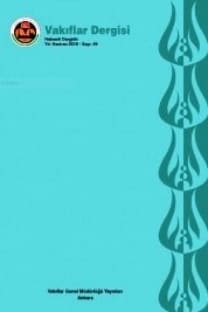Restoration of The Bedesten in Trabzon
Restoration of The Bedesten in Trabzon
Trabzon has had important commercial buildings since it has taken place at the beginning ofthe third caravan route through Asia. The Bedesten in Trabzon is one of these constructions. Itis commonly thought that the Bedesten as the central building of the commercial part of thetown was built by Ottomans in late 15th century in Trabzon.The Bedesten, which lost its original function over time, had structural distortions as being outof use and it tended to collapse. At the end of the 90s the idea of re-use of this structure witha different function which has to be protected as a major cultural asset of the city has beencome up. For this purpose, in collaboration with the Governorship of Trabzon and KaradenizTechnical University, it was regained to the social and trading life of Trabzon by carrying outa restoration project prepared by a working group that includes the authors of this article.This study comprises surveying practices, reconstruction and rehabilitation applications carriedout in restoration phase by introducing historical background and structural properties of theBedesten in Trabzon.
___
- Ballance, Selina (1965). Early Turkish Buildings in Trabzon Ankara: TTK Belleten, 29, (113): 73-76. Ballance, Selina (1997). Trabzondaki Erken Devir Türk Yapıları, Bir Tutkudur Trabzon, Kayaoğlu, İ.Gün- dağ, Ciravoğlu, Ömer, Akalın, Cüneyt (edit.), İstanbul: Yapı Kredi Yayınları: 253-257. Bıjişkyan, P. Minas (1998). Pontos Tarihi Tarihin Horona Durduğu Yer Karadeniz, İstanbul: Çivi Yazıları Yayınları. Bryer, Anthony, Winfield, David (1985). The Byzantine Monuments And Topography Of The Pontos, C.1, Washington D.C. Cerasi, M. Maurice (1999). Osmanlı Kenti, İstanbul: Yapı Kredi Yayınları. Cezar, Mustafa (1983). Typical Commercial Buildings of the Ottoman Classical Period and the Ottoman Construction System, İstanbul: Türkiye İş Bankası Kültür Yayınları: 222-224. Eyice, Semavi (1992). Bedesten, Diyanet Vakfı İslam Ansiklopedisi, C.5., 302-311, İstanbul. Horuluoğlu, Şamil (1992). Trabzon ve Çevresinin Tarihi Eserleri, Ankara: Er Ofset Matbaacılık. İnan, Kenan (1996). Bedestenlerin Türk Ticari Mimarîsindeki Yeri ve Trabzon Bedesteni, Ankara Üniver- sitesi Osmanlı Tarihi Araştırma ve Uygulama Merkezi Dergisi-OTAM 7, Ankara: 119-134. Karpuz, Haşim (1990). Trabzon, Ankara: T. C. Kültür Bakanlığı Yayınları / 1127 Tanıtma Eserler Dizisi / 34. Karpuz, Haşim (1997). Trabzondaki Türk Devri Yapılarına Toplu Bakış, Trabzon Yıllığı. Ankara: Trabzon Belediye Başkanlığı Yayınları, Yayın No:52. Lynch, Harriy Finnis Blosse (1901). Armenia, Travels And Studies, (1), London: 29. Ödekan, Ayla (1997). Bedesten Maddesi, Eczacıbaşı Sanat Ansiklopedisi, (1) İstanbul: Yem Yayınları: 209-210. Sağsöz, Ayşe, Midilli, Reyhan, Elmalı, Derya, Özgen, Süleyman (2003). Tarihi Çevre İçinde Koruma Ça- lışmalarının Arkasından Yaşanan Antagonizm Trabzon Bedesten Örneği, XV. Uluslararası Yapı ve Yaşam Kongresi, Bursa: Mimarlar Odası Bursa Şubesi: 103-132. Temelkuran, Tevfik, Aktaş, Necati (1986). Evliya Çelebi Seyahatnamesi, C.I-II, İstanbul: Üçdal Neşriyat Yayınları: 457 Tezcan, Mehmet (2002). İpekyolu ve XIV. Yüzyıla Kadar İpekyolu Ticaretinde Trabzonun Yeri. Trabzon ve Çevresi Uluslararası Tarih-Dil-Edebiyat Sempozyumu Bildirileri (1): 71-90. Tuluk Ömer İskender, Üstün, Fulya (2007). Trabzon Bedesteni: Türk Bedesten Mimarîsindeki Yeri ve Sorunlarına İlişkin Bir Değerlendirme, Belleten LXXI (262): 923-937. Usta, Veysel (1999). Anabasisten Atatürke Seyahatnamelerde Trabzon, Trabzon: Serander Yayınları: 57- 132.
- ISSN: 1011-7474
- Başlangıç: 2015
- Yayıncı: Mehmet Kurtoğlu
Sayıdaki Diğer Makaleler
Klâsik Osmanlı Sosyal-İktisadî Sistemi ve Vakıflar
Aydınoğulları'ndan Osmanlı'ya Bir Batı Anadolu Kenti: Tire'nin Mekânsal Dönüşümü
Tekke Köyü Hacı Abdullah Halife Camisi Duvar Resimleri
Vakıf Kurucusu Olarak Osmanlı Esnafı (18. Yüzyıl İstanbul Örneği)
Restoration of The Bedesten in Trabzon
H. Emre ENGİN, Erkan AYDINTAN, Cengiz TAVŞAN
İstanbul Kilim ve Düz Dokuma Yaygılar Müzesi
Xıx. Yüzyılda Şeyh Şaban Veli Külliyesi
Trabzon Ayasofya Camii'nin Mülkiyet Hakkı Üzerine Bir İnceleme
Yakup Emre ÇRUHLU, Osman DEMİR
Bir Tarihçinin Kaleminden Osmanlı Dönemi Gördes Halıcılığı Kitabı
Çağlayancerit Kezban Hatun Camiindeki Cicim, Zili Ve Sumak Dokumaları
